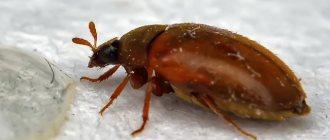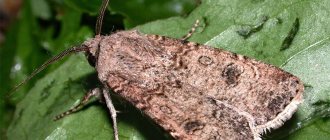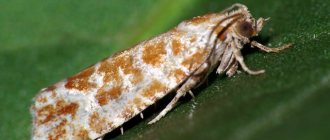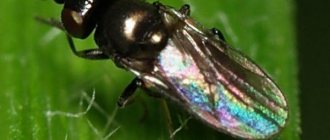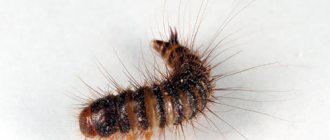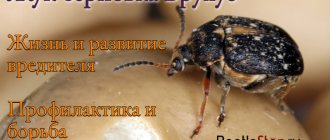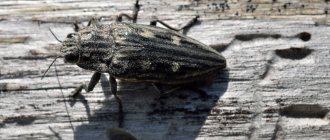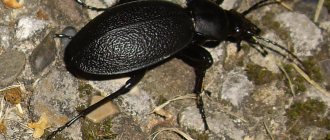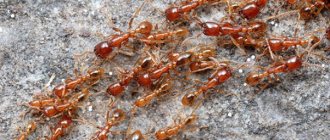The carpet beetle is an inconspicuous and almost invisible bug, which, despite its small size, can cause big problems for humans. Beetles live in nature in bird nests and tree hollows, and in the summer they can get into human housing through open windows or with things brought into the house; there are often cases when they get into a house with a recently purchased flower pot. Few people know or have heard about this type of insect, which is strange, because they are found in houses and apartments quite often.
Warning! A carpet beetle living in a house or apartment poses a serious danger to people and even pets, as these parasites feed on various types of waste and animal remains. The body of such beetles contains many dangerous bacteria and microscopic debris, therefore, they are carriers of dangerous diseases. In addition, the skin beetle painfully bites people and pets, causing discomfort. Therefore, having discovered such residents in your home, you must urgently take measures to destroy them.
Description of carpet beetle
The carpet beetle is an insect ranging in size from two to five millimeters, its color can be from light brown to black. This insect can survive in conditions of sudden temperature changes and unfavorable conditions.
Once in a person’s home, the skin beetle chooses dark and soft places for its habitat and reproduction - closets with clothes, upholstered furniture, carpets, fur products. These insects are afraid of light and are predominantly nocturnal. If a bug accidentally finds itself in an unusual habitat during daylight hours, you will notice that its behavior is extremely slow, and when you touch it, you will see how it skillfully pretends to be dead, falling on its back.
Despite the fact that these parasites are called skin beetles, they feed not only on skin. The list of their food is very extensive; for them there are practically no inedible things: glue, cardboard, synthetics, plastic, gypsum structures, cable, rubber, wool, silk, fluff, fur products, felt, dried and smoked fish, meat, cheese, cereals , dairy products and much more.
In addition to the fact that these bugs significantly harm household things, they are also dangerous to human health, as mentioned above. Such “neighbors” significantly worsen people’s living conditions.
General information
The carpet beetle (also known as the carpet beetle) is not a parasite that lives exclusively in human homes. In nature, their habitat is bird nests in tree hollows. Beetles and their larvae feed on various wastes and remains of animal origin.
He can get into a human home with books, carpets, clothes brought there, or by accidentally flying through a window. And here wool, fur and silk products become its food, but this insect will not refuse human food.
If you find this insect in your home, you should get rid of it as quickly as possible.
How do skin beetles reproduce?
Carpet beetles reproduce quite actively. During her life, the female lays from one dozen to several hundred eggs. The place for future offspring is fleecy and woolen surfaces, upholstered furniture, and the remains of small insects. After laying eggs, the bug dies. The eggs take 2-55 days to develop, depending on conditions and temperature, then they hatch into larvae that cause enormous damage to human property. They can be in the process of maturing into adults for up to two years. The more favorable the conditions, the faster and more rapidly it happens. Unfavorable conditions for insects are dampness and cold.
Skin beetle larvae resemble moth larvae, but if you look closely, despite the similarities, you can find many differences. The carpet beetle larva looks like a furry brown worm with stripes all over its body and long, hair-like tails.
How dangerous is the skin beetle for humans?
Since the insect feeds on the remains and waste of animal origin, it can carry pathogens of various infectious diseases, including worm eggs, on its legs. All this enters the human body with food that the beetle has eaten, or directly through an insect bite. But the leather beetle causes much more real damage to property, because even a small hole in clothes made of natural wool, gnawed by its larva, can hopelessly ruin an expensive item. By the way, people often mistake the damage caused by these insects as the work of moth larvae.
In total, there are about 600 species of skin beetles in the world.
Getting rid of carpet beetles
If a carpet beetle has infested your apartment or house, it is important to know how to get rid of it and what measures to take to quickly and effectively combat uninvited guests. The destruction of these insects requires persistence and patience from homeowners, but it is quite possible. To do this, a number of mandatory work and activities must be completed.
Identification of pests and source of infestation
First, you need to make sure that it is the carpet beetle that is operating in the house. Symptoms of its activity include damage to things, fecal pellets and shed skin; the insects themselves can be found on carpets, furniture, and fur products.
A necessary and important stage in the fight against parasites is identifying sources of infection and reproduction. If stuffed birds and animals are collected at home, there are products made from down and feathers, fur coats and furs, not necessarily natural ones, carpets and rugs, upholstered furniture, fresh flowers, brushes, then these places must first be inspected for the presence of beetles and their larvae and products of their vital activity.
You also need to carefully check all darkened and hard-to-reach places where it is difficult to remove dust and debris, baseboards, crevices and corners behind furniture. Look through clothing closets, food closets, attics, ventilation ducts, closets, bags of old things.
Once the presence of carpet beetles is confirmed and localization sites are identified, measures must be taken immediately to eliminate them.
Important! If a pet lives in the house, fighting bugs and finding a source becomes much more difficult, since cats and dogs leave their fur everywhere, which is an excellent food for skin beetles, the animal moves throughout the apartment, so there can be many areas for pests to spread.
Measures taken to control carpet beetles
The main methods of struggle include:
Thorough cleaning of the premises and areas of infection:
- vacuum carpets and rugs, if possible, take them outside and thoroughly beat and clean them;
- thoroughly wash the floors, paying special attention to hard-to-reach places, spaces under beds, behind furniture;
- steam upholstered furniture once a day until pests are completely eliminated;
- take out and burn heavily damaged items;
- wash clothes, bed linen and furniture covers in hot water with detergents and dry in the sun or in the cold;
- Fur items should be dry cleaned or disposed of if they are too damaged and are not suitable for further use.
You can try using an unconventional method - freezing. Carpets and other damaged items should be taken out into frosty temperatures of minus fifteen degrees. In winter, open the windows and doors of the house and leave for several hours. The beetles and their larvae cannot tolerate temperatures below minus ten degrees. To be sure, the procedure should be performed at least twice. If this method does not help, move on to the fight using chemicals.
Treatment of the premises with special means and aerosols such as:
Chlorpyrifos, Allethrin, Bendiocarb, Diflofos, Raptor, Reid, Chlorophos and other drugs usually used against insects.
Recommendation! Remember that these substances have toxic effects on the human body. Before you start treating the room, you will need to take precautions. It is imperative to use personal protective equipment: gown, mask, gloves to protect the body and respiratory organs from contact with the drug.
The entire space of the apartment, carpeting and affected items, baseboards, cracks, corners behind furniture and all hard-to-reach places where pests can hide are subject to treatment. To completely get rid of parasites, a single use of aerosols is often not enough.
For disinfection, you can use products in the form of solutions, for example, “Supromit”, “Aero-antimol”; to increase their effectiveness, it is better to add PRN to them - an insect regulator that prevents their further reproduction. Solutions are best used to treat hard surfaces.
Using a solution of boric acid, which is not toxic to people and animals, but has a detrimental effect on the carpet beetle and its larvae. This is the safest method, but not as fast as using toxic aerosols. To kill beetles, baseboards, floors, cabinets and intended insect routes should be treated with a boric acid solution. Particles of the solution fall on the skin beetle’s paws, from the paws onto the food, and from there into the body, as a result the beetle dies from poisoning. You can also use boric acid in powder form. It should be scattered in places where insects are localized, on baseboards, under carpets and furniture. But remember that this product has a bleaching effect and may leave stains, especially on dark items and fabrics.
Another option is to place glue traps based on a hormone that attracts insects near affected items, in closets and other places where bugs have been noticed.
Treating wool and fur products with a weak solution of the pyrethroid permatrin can save you not only from skin beetles, but also from clothes moths for a whole year.
It is recommended to place fumigants or Antimol tablets in cabinets and other places attractive to pests; they will not kill an adult, but the larvae will happily eat them and become poisoned.
Exterior treatment of the house. Spray the insecticide around the perimeter of the room, along areas near the house and along the bottom of the foundation. If we are talking about a private home, procedures outside are extremely important, since infection often occurs from a ventilation hole or a place connected to the street. For the best result, 90 cm of the height of the house and 90 cm of the area around the perimeter of the house should be treated. Other potential entry points should also be treated: windows, doors, ventilation and utility pipes.
Remove nests of birds and bees around the house or in the yard, on the apartment balcony or on branches close to your window, as their presence increases the risk of pest infestation.
If the carpet beetle infestation has reached global proportions, hire a professional. Exterminators will use powerful and effective chemicals to perform a more thorough treatment and eliminate dangerous pests from your home.
How to understand that there are skin beetles in the house: main signs
To effectively fight carpet beetles, you need to make sure that it is them. Their appearance in a home can be recognized by certain signs:
- after the pests molt, chitinous shells remain;
- holes appear on things and household items made of organic and natural materials;
- granules of larval feces are found in secluded places in the home;
- on a piece of fur or carpet you saw a bug of a brownish or black color or a brownish tint, an individual in the first stage of development, covered with tufts of bristles.
Larvae, like young beetles, do not tolerate light well, so most often they can be found in shaded or dark corners of the home. They often settle in places such as:
- kitchen cabinets containing cereals and flour;
- carpets;
- cushioned furniture;
- things made of fur and wool.
Colonies of skin beetles can be detected behind baseboards, wallpaper coming off walls, in ventilation, in the attic, etc.
Your favorite sweater may look like this after it is attacked by a skin beetle larva.
Preventive measures
Prevention is always cheaper and easier than exterminating existing pests, so in order to avoid problems associated with carpet beetles, the following measures must be observed:
- store clothes in tightly closed cases;
- place naphthalene tablets or lavender-scented tablets that repel insects in cabinets and hard-to-reach places;
- cover windows with mosquito nets;
- periodically inspect and sort through clothes and linen;
- keep the room clean, systematically do thorough general cleaning, clean carpets and furniture.
If you monitor the cleanliness of your home and the condition of your belongings, you can avoid such unpleasant neighbors as carpet beetles. Even if they accidentally entered the room, if you find them in time and know how to get rid of carpet beetles, you can remove these pests yourself.
Reproduction of pest beetles
Carpet beetles easily and in a short time increase their number.
One individual, in order to leave offspring, lays ten or a couple of hundred eggs. Location of beetles - chairs, beds, carpets and the like. Having laid eggs, the female dies. In two days or over the course of two months, depending on the circumstances and air temperature, larvae appear that are harmful to human property. They grow into an adult beetle within two years.
Expert opinion
Mityuk Stefania Bogdanovna
The better the environment, the faster the maturation. The insect does not tolerate coolness and high humidity. They look like moth larvae. The carpet beetle's larvae are fleecy and brown in color with stripes and tails.
Where do skin beetles live in an apartment? How to find these beetles?
Adult beetles fly around the apartment and can unexpectedly and loudly “fly into someone’s forehead” without calculating their flight path. Until this happens, it is better to be the first to find those who replenish their fat reserves by destroying valuable materials. The beetle prefers warm, dry places; they can often be found near a radiator, on a windowsill, in a closet drawer, as well as under carpets, in and near sofas, in mattresses, etc. Skin beetles are often seen in the kitchen; for example, many people find beetles with their legs upside down on the kitchen stove.
There can be much more beetles than it might seem at first glance, because most of them are hidden from human eyes in the form of larvae that have gnawed into the substrate, which are actually engaged in sabotage of valuable materials, products, etc. Until you find out what attracts beetles to your home, it will be impossible to localize the source of their spread.
Carefully inspect your sofa, especially its upholstery, from all sides. This place is the most frequent stronghold of skin beetle larvae.
It also happens that there is simply no specific outbreak - clothes in closets, contaminated cereals, etc. For example, carpet beetles choose hard-to-reach places from which dust and dirt are rarely swept away, or where they accumulate most quickly. The larvae of these beetles feed on a layer of dust, small pieces of various materials - paper, carpet lint, hair and various organic debris. This kind of residue appears in any apartment within a couple of days after cleaning, under cabinets, beds, etc. (even if no one lives in it).
“Where do skin beetle larvae most often like to settle? Under the baseboards. Trite? Maybe, but sometimes there’s just nowhere for them to hide like underneath.”
Adult Smirnov's skin beetles, as a rule, crawl onto windows and lamps; they can be found between window frames or inside lamp shades.
